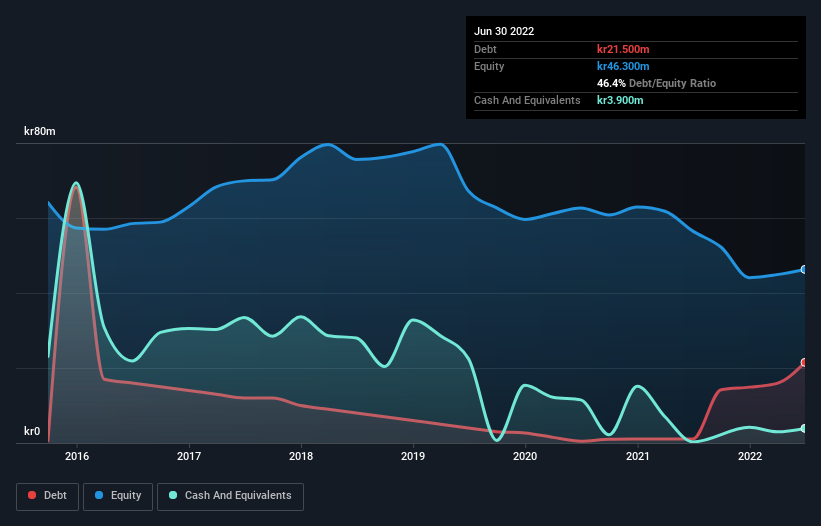Howard Marks put it nicely when he said that, rather than worrying about share price volatility, 'The possibility of permanent loss is the risk I worry about... and every practical investor I know worries about.' So it might be obvious that you need to consider debt, when you think about how risky any given stock is, because too much debt can sink a company. We note that Hifab Group AB (publ.) (STO:HIFA B) does have debt on its balance sheet. But the real question is whether this debt is making the company risky.
When Is Debt Dangerous?
Debt and other liabilities become risky for a business when it cannot easily fulfill those obligations, either with free cash flow or by raising capital at an attractive price. If things get really bad, the lenders can take control of the business. However, a more usual (but still expensive) situation is where a company must dilute shareholders at a cheap share price simply to get debt under control. By replacing dilution, though, debt can be an extremely good tool for businesses that need capital to invest in growth at high rates of return. The first step when considering a company's debt levels is to consider its cash and debt together.
View our latest analysis for Hifab Group AB (publ.)
What Is Hifab Group AB (publ.)'s Net Debt?
You can click the graphic below for the historical numbers, but it shows that as of June 2022 Hifab Group AB (publ.) had kr21.5m of debt, an increase on kr1.10m, over one year. However, it also had kr3.90m in cash, and so its net debt is kr17.6m.

How Strong Is Hifab Group AB (publ.)'s Balance Sheet?
According to the last reported balance sheet, Hifab Group AB (publ.) had liabilities of kr100.7m due within 12 months, and liabilities of kr7.60m due beyond 12 months. On the other hand, it had cash of kr3.90m and kr104.4m worth of receivables due within a year. So these liquid assets roughly match the total liabilities.
This state of affairs indicates that Hifab Group AB (publ.)'s balance sheet looks quite solid, as its total liabilities are just about equal to its liquid assets. So while it's hard to imagine that the kr107.1m company is struggling for cash, we still think it's worth monitoring its balance sheet. When analysing debt levels, the balance sheet is the obvious place to start. But it is Hifab Group AB (publ.)'s earnings that will influence how the balance sheet holds up in the future. So when considering debt, it's definitely worth looking at the earnings trend. Click here for an interactive snapshot.
Over 12 months, Hifab Group AB (publ.) made a loss at the EBIT level, and saw its revenue drop to kr298m, which is a fall of 10%. That's not what we would hope to see.
Caveat Emptor
Not only did Hifab Group AB (publ.)'s revenue slip over the last twelve months, but it also produced negative earnings before interest and tax (EBIT). Indeed, it lost kr7.8m at the EBIT level. Looking on the brighter side, the business has adequate liquid assets, which give it time to grow and develop before its debt becomes a near-term issue. But we'd want to see some positive free cashflow before spending much time on trying to understand the stock. So it seems too risky for our taste. There's no doubt that we learn most about debt from the balance sheet. However, not all investment risk resides within the balance sheet - far from it. To that end, you should be aware of the 4 warning signs we've spotted with Hifab Group AB (publ.) .
Of course, if you're the type of investor who prefers buying stocks without the burden of debt, then don't hesitate to discover our exclusive list of net cash growth stocks, today.
Valuation is complex, but we're here to simplify it.
Discover if Hultstrom Group might be undervalued or overvalued with our detailed analysis, featuring fair value estimates, potential risks, dividends, insider trades, and its financial condition.
Access Free AnalysisHave feedback on this article? Concerned about the content? Get in touch with us directly. Alternatively, email editorial-team (at) simplywallst.com.
This article by Simply Wall St is general in nature. We provide commentary based on historical data and analyst forecasts only using an unbiased methodology and our articles are not intended to be financial advice. It does not constitute a recommendation to buy or sell any stock, and does not take account of your objectives, or your financial situation. We aim to bring you long-term focused analysis driven by fundamental data. Note that our analysis may not factor in the latest price-sensitive company announcements or qualitative material. Simply Wall St has no position in any stocks mentioned.
About OM:HULT B
Hultstrom Group
Provides project management and consulting services in Sweden, rest of Europe, Asia, and Africa.
Solid track record with excellent balance sheet and pays a dividend.
Market Insights
Community Narratives



